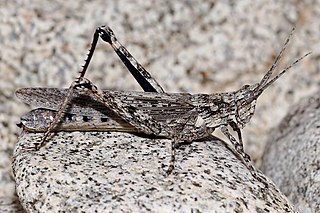
The orthopteran family Rhaphidophoridae of the suborder Ensifera has a worldwide distribution. Common names for these insects include cave crickets, camel crickets, spider crickets, and sand treaders. Those occurring in New Zealand are typically referred to as jumping or cave wētā. Most are found in forest environments or within caves, animal burrows, cellars, under stones, or in wood or similar environments. All species are flightless and nocturnal, usually with long antennae and legs. More than 500 species of Rhaphidophoridae are described.

Acrididae are the predominant family of grasshoppers, comprising some 10,000 of the 11,000 species of the entire suborder Caelifera. The Acrididae are best known because all locusts are of the Acrididae. The subfamily Oedipodinae is sometimes classified as a distinct family Oedipodidae in the superfamily Acridoidea. Acrididae grasshoppers are characterized by relatively short and stout antennae, and tympana on the side of the first abdominal segment.

Tetrigidae is an ancient family in the order Orthoptera, which also includes similar families such as crickets, grasshoppers, and their allies. Species within the Tetrigidae are variously called groundhoppers, pygmy grasshoppers, pygmy devils or "grouse locusts".

Pyrgomorphidae is a family of grasshoppers in the order Orthoptera; it is the only family in the superfamily Pyrgomorphoidea. Pyrgomorphidae are found worldwide in tropical and warm temperate regions, but the vast majority of the family's approximately 500 species are from Africa, Asia and Australia. Their name is probably derived from pyrgos meaning "tower": a reference to the form (morph) of the head in the type genus Pyrgomorpha and other genera.

Discotettix is a genus of groundhoppers found in Malesia, Brunei, Indonesia and the Philippines; they may be known as "spiky pygmy devils". After revision, it is the type genus of the tribe Discotettigini and now placed in the subfamily Scelimeninae.

Scelimena is a genus of ground hoppers in the family Tetrigidae, with records from India, Indo-China, Malesia and Papua New Guinea.

Conocephalinae, meaning "conical head", is an Orthopteran subfamily in the family Tettigoniidae.

Caryanda is a large genus of grasshoppers in the subfamily Caryandinae. Species are recorded from Africa and Asia.
Arulenus is a genus of pygmy grasshopper. As of 2016, it consists of two species:

Batrachideinae is a subfamily of groundhoppers or pygmy grasshoppers. There are thought to be 20 genera in Batrachideinae, with genera found in the Americas, Africa, Asia and Australia.

Scelimeninae is a subfamily of Asian ground hoppers.

Cladonotinae is a subfamily of groundhoppers containing more than 70 genera and 260 described species. These insects are found in tropical areas world-wide.

Metrodorinae is a subfamily of groundhoppers or pygmy grasshoppers. There are at least 90 genera and more than 590 described species, found in South America, Africa and Asia.

The Orthopteran subfamily Aemodogryllinae contains about sixteen genera of camel crickets. It was named after AemodogryllusAdelung, 1902 - which is now considered a subgenus of Diestrammena.
Coptotettix is an Asian genus of ground-hoppers in the subfamily Tetriginae.

Gerenia is a genus of grasshoppers in the subfamily Catantopinae and tribe Gereniini. Species can be found in India and Indo-China.
Tripetaloceroides is a genus of Asian groundhoppers in the subfamily Tripetalocerinae and tribe Tripetalocerini Bolívar, 1887.
Cleostratoides is a genus of ground-hoppers in the subfamily Metrodorinae and not assigned to any tribe.
Cota is a genus of pygmy grasshoppers in the family Tetrigidae. There are at least three described species in Cota.

Roeseliana is a genus of bush cricket or katydid in the subfamily Tettigoniinae. Species in this genus were placed at various times in the genera Metrioptera and Bicolorana, until Roeseliana was restored in 2011, with these and other similar genera placed in genus group Metrioptera.














